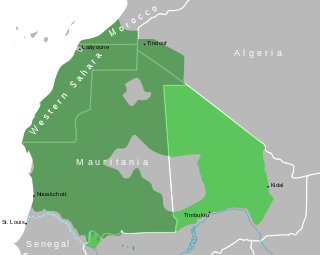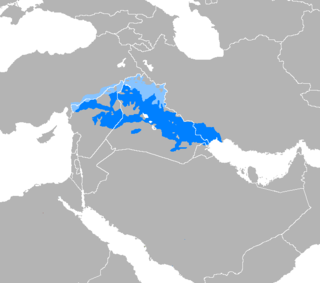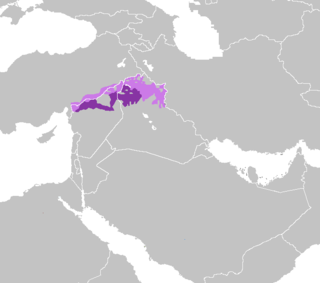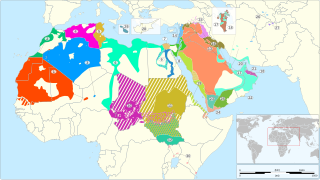Related Research Articles

Hassaniya Arabic is a variety of Maghrebi Arabic spoken by Mauritanian and Malian Arabs and the Sahrawi people. It was spoken by the Beni Ḥassān Bedouin tribes of Yemeni origin who extended their authority over most of Mauritania and Western Sahara between the 15th and 17th centuries. Hassaniya Arabic was the language spoken in the pre-modern region around Chinguetti.
While many languages have numerous dialects that differ in phonology, contemporary spoken Arabic is more properly described as a continuum of varieties. This article deals primarily with Modern Standard Arabic (MSA), which is the standard variety shared by educated speakers throughout Arabic-speaking regions. MSA is used in writing in formal print media and orally in newscasts, speeches and formal declarations of numerous types.

Gulf Arabic or Khaleeji is a variety of the Arabic language spoken in Eastern Arabia around the coasts of the Persian Gulf in Kuwait, Bahrain, Qatar, the United Arab Emirates, southern Iraq, eastern Saudi Arabia, northern Oman, and by some Iranian Arabs.

Mesopotamian Arabic, also known as Iraqi Arabic, or just as Iraqi, is a group of varieties of Arabic spoken in the Mesopotamian basin of Iraq, as well as in Syria, southeastern Turkey, Iran, Kuwait and Iraqi diaspora communities.
Gimel is the third letter of the Semitic abjads, including Arabic ǧīmج, Aramaic gāmal 𐡂, Hebrew gīmelג, Phoenician gīml 𐤂, and Syriac gāmal ܓ. Its sound value in the original Phoenician and in all derived alphabets, except Arabic, is a voiced velar plosive. In Modern Standard Arabic, it represents either a or for most Arabic speakers except in Northern Egypt, the southern parts of Yemen and some parts of Oman where it is pronounced as the voiced velar plosive.

Najdi Arabic is the group of Arabic varieties originating from the Najd region of Saudi Arabia. Outside of Saudi Arabia, it is also the main Arabic variety spoken in the Syrian Desert of Iraq, Jordan, and Syria as well as the westernmost part of Kuwait.

Hejazi Arabic or Hijazi Arabic (HA), also known as West Arabian Arabic, is a variety of Arabic spoken in the Hejaz region in Saudi Arabia. Strictly speaking, there are two main groups of dialects spoken in the Hejaz region, one by the urban population, originally spoken mainly in the cities of Jeddah, Mecca, Medina and partially in Ta'if and another dialect by the urbanized rural and bedouin populations. However, the term most often applies to the urban variety which is discussed in this article.
The Arabic language family is divided into several categories which are: Old Arabic, the literary varieties, and the modern vernaculars.
Kuwaiti is a Gulf Arabic dialect spoken in Kuwait. Kuwaiti Arabic shares many phonetic features unique to Gulf dialects spoken in the Arabian Peninsula. Due to Kuwait's soap opera industry, knowledge of Kuwaiti Arabic has spread throughout the Arabic-speaking world and become recognizable even to people in countries such as Tunisia and Jordan.

North Mesopotamian Arabic, also known as Moslawi, Mardelli, Mesopotamian Qeltu Arabic, or Syro-Mesopotamian Arabic, is one of the two main varieties of Mesopotamian Arabic, together with Gilit Mesopotamian Arabic.

Chadian Arabic, also known as Shuwa Arabic, Western Sudanic Arabic, or West Sudanic Arabic (WSA), is a variety of Arabic and the first language of 1.6 million people, both town dwellers and nomadic cattle herders. Most of its speakers live in central and southern Chad. Its range is an east-to-west oval in the Sahel. Nearly all of this territory is within Chad and Sudan. It is also spoken elsewhere in the vicinity of Lake Chad in the countries of Cameroon, Nigeria and Niger. Finally, it is spoken in slivers of the Central African Republic. In addition, this language serves as a lingua franca in much of the region. In most of its range, it is one of several local languages and often not among the major ones.
Northwest Arabian Arabic is a proposed subfamily of Arabic encompassing the traditional Bedouin dialects of the Sinai Peninsula, the Negev, Gaza Strip, southern Jordan, and the northwestern corner of Saudi Arabia.

Varieties of Arabic are the linguistic systems that Arabic speakers speak natively. Arabic is a Semitic language within the Afroasiatic family that originated in the Arabian Peninsula. There are considerable variations from region to region, with degrees of mutual intelligibility that are often related to geographical distance and some that are mutually unintelligible. Many aspects of the variability attested to in these modern variants can be found in the ancient Arabic dialects in the peninsula. Likewise, many of the features that characterize the various modern variants can be attributed to the original settler dialects as well as local native languages and dialects. Some organizations, such as SIL International, consider these approximately 30 different varieties to be separate languages, while others, such as the Library of Congress, consider them all to be dialects of Arabic.

Jordanian Arabic is a dialect continuum of mutually intelligible varieties of Arabic spoken in Jordan.

Peninsular Arabic are the varieties of Arabic spoken throughout the Arabian Peninsula. This includes the countries of Saudi Arabia, Yemen, Oman, United Arab Emirates, Kuwait, Bahrain, Qatar, Southern Iran, Southern Iraq and Jordan.
Palatalization is a historical-linguistic sound change that results in a palatalized articulation of a consonant or, in certain cases, a front vowel. Palatalization involves change in the place or manner of articulation of consonants, or the fronting or raising of vowels. In some cases, palatalization involves assimilation or lenition.
This article is about the phonology of Levantine Arabic also known as Shāmi Arabic, and its sub-dialects.

EmiratiArabic, also known as Al Ramsa, refers to a group of Arabic dialectal varieties spoken by the Emiratis native to the United Arab Emirates that share core characteristics with specific phonological, lexical, and morphosyntactic features and a certain degree of intra-dialectal variation, which is mostly geographically defined. It incorporates grammatical properties of smaller varieties within the UAE, generally of tribal nature, which can be roughly divided into a couple of broader sub-varieties: the first spoken in the Northern Emirates of Dubai, Sharjah, Ajman, Umm al-Quwain, and the western part of Ras al-Khaimah; the second in the eastern part of the country, mainly in Fujeirah, Dibba, Khor Fakkan, Hatta, Kalba, and the eastern part of Ras al-Khaimah; the third in Abu Dhabi including the oasis city of Al Ain, the dialect is also seen in the Omani region of Al-Buraimi. Emirati Arabic varieties can also be distinguished based on environmental factors, including variations associated with Bedouin communities, coastal, agricultural, and mountainous regions.
Gilit Mesopotamian Arabic, also known as Iraqi Arabic, Mesopotamian Gelet Arabic, or simply Mesopotamian Arabic is one of the two main varieties of Mesopotamian Arabic, together with North Mesopotamian Arabic.
Shawi or Šāwi Arabic is the Arabic dialect of the sheep-rearing Bedouins of Syro-Mesopotamia. The term Šāwi typically refers to the tribes living between the Tigris and the Euphrates, but many tribes are also found elsewhere, such as northern Jordan, Palestine, western Syria, and Lebanon. The dialect of the Arabs of Urfa also belongs to the Šāwi-Bedouin group.
References
- ↑ Weninger, Stefan, ed. (21 December 2011). The Semitic Languages: An International Handbook. doi:10.1515/9783110251586. ISBN 978-3-11-018613-0.
- 1 2 Magidow, Alexander (December 2021). "The Old and the New: Considerations in Arabic Historical Dialectology". Languages. 6 (4): 163. doi: 10.3390/languages6040163 . ISSN 2226-471X.
- ↑ Palva, Heikki (2011-05-30), "Dialects: Classification", Encyclopedia of Arabic Language and Linguistics, Brill, doi:10.1163/1570-6699_eall_eall_com_0087 , retrieved 2023-01-01
- ↑ Younes, Igor; Herin, Bruno (2016-01-01). "Šāwi Arabic". Encyclopedia of Arabic Language and Linguistics Online Edition.
- ↑ Webster, Roger (1991). "Notes on the Dialect and Way of Life of the Āl Wahība Bedouin of Oman". Bulletin of the School of Oriental and African Studies, University of London. 54 (3): 473–485. doi:10.1017/S0041977X00000835. ISSN 0041-977X. JSTOR 619056.
- ↑ Manfredi, Stefano; Roset, Caroline (September 2021). "Towards a Dialect History of the Baggara Belt". Languages. 6 (3): 146. doi: 10.3390/languages6030146 . hdl: 11245.1/9d3da5f3-7f63-4424-a557-8ce609adb526 . ISSN 2226-471X.